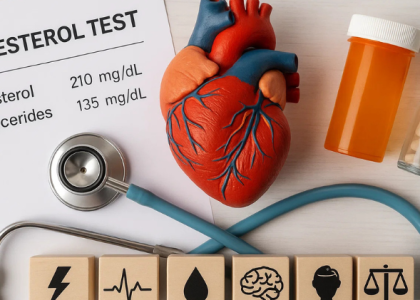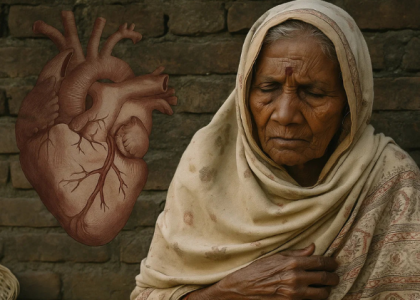Did you know? South Asians (people from India, Pakistan, Bangladesh, Sri Lanka, Nepal, and Bhutan) have higher risk of stroke than many other groups. The good news is that up to 80% of strokes can be prevented by making healthy choices every day.
Use this simple checklist to lower your stroke risk:
✓ Know Your Blood Pressure Numbers
☐ Get your blood pressure checked at least once a year
☐ Aim for a reading below 120/80
☐ If it’s high, work with your doctor on a plan to lower it
Why this matters: High blood pressure is the #1 cause of stroke. South Asians often develop high blood pressure at younger ages and at lower body weights than other groups [1].
Simple step: Reduce salt in your cooking. Try using more spices and herbs instead of salt for flavor.
✓ Control Your Blood Sugar
☐ Get tested for diabetes, especially if you have family history
☐ Check your HbA1c (long-term blood sugar) yearly
☐ If you have diabetes, keep your blood sugar in the target range
Why this matters: South Asians have higher rates of diabetes than most other ethnic groups, and diabetes doubles your risk of stroke [2].
Simple step: Reduce white rice portions by mixing with brown rice, or replace with more vegetables and protein.
✓ Get Your Cholesterol Checked
☐ Have a full lipid profile done yearly after age 30
☐ Know your numbers: Total, LDL (“bad”), HDL (“good”)
☐ Take cholesterol medication if prescribed by your doctor
Why this matters: South Asians tend to have higher LDL and lower HDL cholesterol, which increases stroke risk [3].
Simple step: Use heart-healthy oils like olive or mustard oil instead of ghee or coconut oil for some of your cooking.
✓ Eat an Anti-Inflammatory Diet
☐ Add more colorful vegetables to your meals
☐ Include heart-healthy fats (nuts, seeds, fish if you eat it)
☐ Reduce fried foods and sweets
☐ Choose whole grains over refined ones
Why this matters: Inflammation in blood vessels can lead to blockages that cause stroke.
Simple step: Try to fill half your plate with vegetables at each meal.
✓ Move Your Body Daily
☐ Aim for 30 minutes of activity 5 days a week
☐ Include both cardio (walking, dancing) and strength exercises
☐ Even short 10-minute sessions throughout the day count
Why this matters: Regular exercise helps control blood pressure, cholesterol, and blood sugar levels.
Simple step: Walk for 10 minutes after each meal. This adds up to 30 minutes daily and helps control blood sugar.
✓ Maintain a Healthy Weight
☐ Know that waist size matters more than weight
☐ For South Asian men: Keep waist below 35 inches (90 cm)
☐ For South Asian women: Keep waist below 31.5 inches (80 cm)
Why this matters: Even thin South Asians can have dangerous internal fat around organs that increases stroke risk [4].
Simple step: Focus on healthy habits rather than just weight loss. The weight will follow.
✓ Don’t Smoke or Use Tobacco
☐ Quit all forms of tobacco (cigarettes, bidis, hookah, chewing tobacco)
☐ Avoid secondhand smoke
☐ Ask your doctor about quitting aids if needed
Why this matters: Smoking doubles your risk of stroke by damaging blood vessels and raising blood pressure [5].
Simple step: If you smoke, set a quit date and tell your family and friends so they can support you.
✓ Limit Alcohol
☐ If you drink, do so in moderation
☐ For women: No more than 1 drink per day
☐ For men: No more than 2 drinks per day
Why this matters: Heavy drinking raises blood pressure and can trigger irregular heartbeats that increase stroke risk [6].
Simple step: Try alcohol-free alternatives at social gatherings, like flavored seltzers or mocktails.
✓ Manage Your Stress
☐ Practice stress reduction techniques daily
☐ Try meditation, deep breathing, or yoga
☐ Get 7-8 hours of quality sleep each night
Why this matters: Chronic stress raises blood pressure and inflammation, both risk factors for stroke [7].
Simple step: Take 5 deep breaths whenever you feel stressed or set a reminder to do so every hour.
✓ Know the Warning Signs of Stroke
Remember the FAST way to spot a stroke:
F = Face Drooping
Is one side of the face drooping or numb? Ask the person to smile. Is their smile uneven?
A = Arm Weakness
Is one arm weak or numb? Ask them to raise both arms. Does one arm drift downward?
S = Speech Difficulty
Is speech slurred? Is the person unable to speak or hard to understand? Ask them to repeat a simple sentence.
T = Time to Call Emergency Services
If someone shows any of these symptoms, even if they go away, call emergency services (911) immediately. Note the time when symptoms first appeared.
Why this matters: Getting treatment within 3 hours of the first symptoms can greatly reduce the damage caused by stroke [8].
Simple step: Save emergency numbers in your phone and teach your family the FAST method.
Remember: Even if you have a family history of stroke, most strokes can be prevented by taking action now. Start with one or two changes from this checklist and add more over time.
You don’t need to be perfect. Small steps add up to big results for your health!
References
- American Heart Association. (2023). “Atherosclerotic Cardiovascular Disease in South Asians in the United States.” Circulation, 138(1), e1-e34.
- Kanaya, A.M., et al. (2022). “Understanding the high prevalence of diabetes in U.S. South Asians compared with four racial/ethnic groups: the MASALA and MESA studies.” Diabetes Care, 37(6), 1621-1628.
- Volgman, A.S., et al. (2018). “South Asians’ high risk of cardiovascular disease: A review of current research and recommendations for prevention.” Journal of the American Heart Association, 7(13), e010522.
- Sniderman, A.D., et al. (2017). “Why might South Asians be so susceptible to central obesity and its atherogenic consequences? The adipose tissue overflow hypothesis.” International Journal of Epidemiology, 36(1), 220-225.
- Centers for Disease Control and Prevention. (2024). “Smoking and Heart Disease and Stroke.” https://www.cdc.gov/tobacco/basic_information/health_effects/heart_disease/index.htm
- National Institute on Alcohol Abuse and Alcoholism. (2023). “Alcohol’s Effects on Health.” https://www.niaaa.nih.gov/alcohols-effects-health
- Harvard Health Publishing. (2023). “Understanding the stress response.” Harvard Medical School. https://www.health.harvard.edu/staying-healthy/understanding-the-stress-response
- American Stroke Association. (2024). “Stroke Symptoms.” https://www.stroke.org/en/about-stroke/stroke-symptoms




